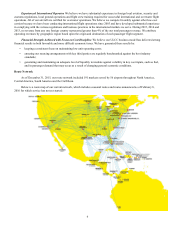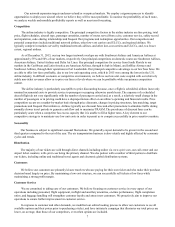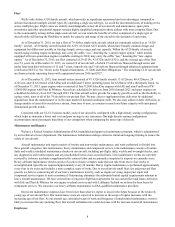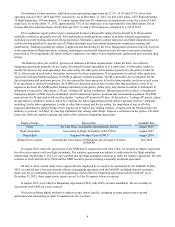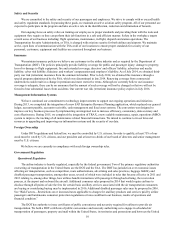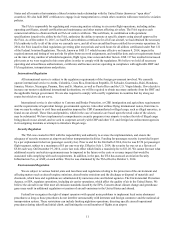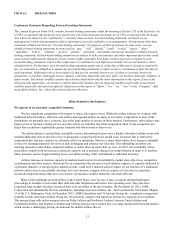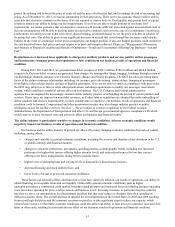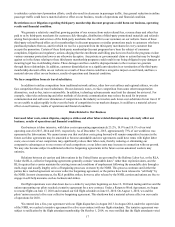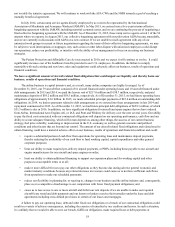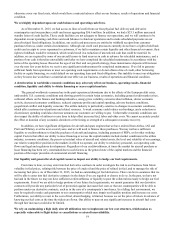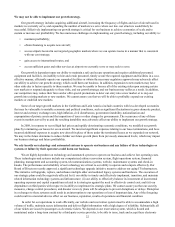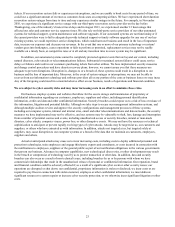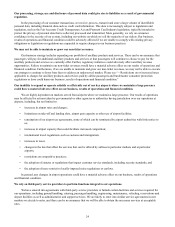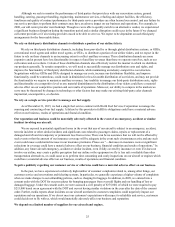Spirit Airlines 2015 Annual Report Download - page 16
Download and view the complete annual report
Please find page 16 of the 2015 Spirit Airlines annual report below. You can navigate through the pages in the report by either clicking on the pages listed below, or by using the keyword search tool below to find specific information within the annual report.16
The airline industry faces ongoing security concerns and related cost burdens, furthered by threatened or actual
terrorist attacks or other hostilities that could significantly harm our industry and our business.
The terrorist attacks of September 11, 2001 and their aftermath negatively affected the airline industry. The primary
effects experienced by the airline industry included:
• substantial loss of revenue and flight disruption costs caused by the grounding of all commercial air traffic in or
headed to the United States by the FAA for three days after the terrorist attacks;
• increased security and insurance costs;
• increased concerns about future terrorist attacks;
• airport shutdowns and flight cancellations and delays due to security breaches and perceived safety threats; and
• significantly reduced passenger traffic and yields due to the subsequent dramatic drop in demand for air travel.
Since September 11, 2001, the Department of Homeland Security and the TSA have implemented numerous security
measures that restrict airline operations and increase costs, and are likely to implement additional measures in the future. For
example, following the widely publicized attempt of an alleged terrorist to detonate plastic explosives hidden underneath his
clothes on a Northwest Airlines flight on Christmas Day in 2009, passengers became subject to enhanced random screening,
which included pat-downs, explosive detection testing and body scans. Enhanced passenger screening, increased regulation
governing carry-on baggage and other similar restrictions on passenger travel may further increase passenger inconvenience
and reduce the demand for air travel. In addition, increased or enhanced security measures have tended to result in higher
governmental fees imposed on airlines, resulting in higher operating costs for airlines, which we may not be able to pass on to
consumers in the form of higher prices. Any future terrorist attacks or attempted attacks, even if not made directly on the airline
industry, or the fear of such attacks or other hostilities (including elevated national threat warnings or selective cancellation or
redirection of flights due to terror threats) would likely have a material adverse effect on our business, results of operations and
financial condition and on the airline industry in general.
Airlines are often affected by factors beyond their control including: air traffic congestion at airports; air traffic control
inefficiencies; adverse weather conditions, such as hurricanes or blizzards; increased security measures; new travel
related taxes or the outbreak of disease, any of which could harm our business, operating results and financial
condition.
Like other airlines, our business is affected by factors beyond our control, including air traffic congestion at airports, air
traffic control inefficiencies, adverse weather conditions, increased security measures, new travel related taxes and the outbreak
of disease. Factors that cause flight delays frustrate passengers and increase costs, which in turn could adversely affect
profitability. The federal government singularly controls all U.S. airspace, and airlines are completely dependent on the FAA to
operate that airspace in a safe, efficient and affordable manner. The air traffic control system, which is operated by the FAA,
faces challenges in managing the growing demand for U.S. air travel. U.S. and foreign air-traffic controllers often rely on
outdated technologies that routinely overwhelm the system and compel airlines to fly inefficient, indirect routes resulting in
delays. Adverse weather conditions and natural disasters, such as hurricanes affecting southern Florida and the Caribbean as
well as other areas of the eastern United States (such as Hurricane Sandy in October 2012), winter snowstorms or the January
2010 earthquakes in Port-au-Prince, Haiti, can cause flight cancellations or significant delays. For example, during the second
quarter of 2015, we experienced consecutive storm systems in Dallas, Chicago, New York and Detroit followed by Tropical
Storm Bill that sat over Houston before moving north to Dallas. The timing and location of these storm systems produced a
domino effect on our operations resulting in over 500 flight cancellations and numerous flight delays, which resulted in an
adverse effect on our results of operations. Cancellations or delays due to adverse weather conditions or natural disasters, air
traffic control problems or inefficiencies, breaches in security or other factors may affect us to a greater degree than other,
larger airlines that may be able to recover more quickly from these events, and therefore could harm our business, results of
operations and financial condition to a greater degree than other air carriers. Because of our high utilization, point-to-point
network, operational disruptions can have a disproportionate impact on our ability to recover. In addition, many airlines
reaccommodate their disrupted passengers on other airlines at prearranged rates under flight interruption manifest agreements.
We have been unsuccessful in procuring any of these agreements with our peers, which makes our recovery from disruption
more challenging than for larger airlines that have these agreements in place. Similarly, outbreaks of pandemic or contagious
diseases, such as ebola, measles, avian flu, severe acute respiratory syndrome (SARS), H1N1 (swine) flu and Zika virus, could
result in significant decreases in passenger traffic and the imposition of government restrictions in service and could have a
material adverse impact on the airline industry. Increased travel taxes, such as those provided in the Travel Promotion Act,
enacted March 10, 2010, which charges visitors from certain countries a $10 fee every two years to travel into the United States


